Mehinako
- Self-denomination
- Where they are How many
- MT 341 (Siasi/Sesai, 2020)
- Linguistic family
- Aruak
Inhabitants of the culture area/region known as the upper Xingu (encompassed by the Indigenous Park of the Xingu, the Mehinako belong to a broad complex of peoples who show few differences amongst themselves. The specialized system of commercial trade, the intersocietal rituals, and the patterns of intermarriage at once bind the Mehinako to other ethnic groups which surround them and distinguish them from this network. However, in the midst of their similarities with other peoples of the upper Xingu, the Mehinako consider themselves above all to be Mehinako, and are proud of being a special human community.
History of occupation in the upper Xingu

In recounting their past, the Mehinako describe only a few generations of ancestors before reaching the "mythical times" (ekyimyatipa), when the culture heroes and the spirits created humans, social institutions and the geography of the region of the Xingu.
As far as is known, the Mehinako have always lived in the Xingu basin, in the region of the Tuatuari and Kurisevo rivers. The first village for which there is any record is Yulutakitsi, which must have been inhabited 150 or more years ago in an uncertain locale. What makes Yulutakitsi especially intriguing is that the group was, at that time, divided into moieties, each of which lived in triple rows of houses, on opposite sides of the central plaza. According to several inhabitants of the village, the social frontier was marked by a small fence which crossed the center of the plaza, but others state that it was the bench in front of the men's house which served as the dividing line. As the Mehinako chief Aiyuruwa said:
"We did not marry a woman on our side. We married on the other side. And when someone of the other side died, we did not cry for them nor did we undo our belts and our body paintings. Only they were in mourning".
The only possible vestige of this organization in moieties among the contemporary Mehinako is the pattern in which the houses of chiefs have to be placed facing each other, and with each new move of the community they are oriented in the direction of their "opposites" on the other side of the village.
The historical Mehinako villages were located to the north of the present-day Aweti village, on the Tuatuari River. The Mehinako go back to these communities every year to gather pequi fruit and to make salt (potassium chloride) with a species of water plant called jacinto, found in the lakes of the region. For the Mehinako, these places are their traditional habitat. The abandoning of these communities was due to various reasons, such as the exhaustion of the fertility of soils, nearness to many leaf-cutter (saúva) ant colonies, the occurrence of many deaths in one place and the belief that the constructions and the trails of the community had become too large and degraded, causing problems for their reconstruction.
All the old villages are described nostalgically by the Mehinako as being larger and better than their present community. It is said that in the past, the central plaza was surrounded by several rows of houses instead of just one. People were free of the white man's sicknesses (even the flus were unknown), the fish was more abundant and the gossip more intense.
At the moment of the first visit by the German explorer Karl von den Steinen, in 1884, the Mehinako had three separate villages, although one of them may have been only a camping site in the dry season (uleinejepu). It is probable that the present population of about 183 inhabitants is only a little more than a quarter of what it was in the days of von den Steinen. The Mehinako villages customarily had many more families and houses than in the present.
The relocation of the Mehinako villages from their traditional territories was provoked by the arrival of the Ikpeng, a Karib-speaking group, in the mid-1950s, who attacked the inhabitants of the village with a heavy rain of arrows. When the Mehinako chief was struck in the back by an Ikpeng arrow, the Villas-Bôas brothers encouraged the inhabitants of the village to abandon their territory and move to a place closer to the post. The Yawalapiti had done the same, at the same time, in order to escape the Ikpeng. One kilometer from the post, the Yawalapiti gave the Mehinako their first house, Jalapapuh, "the place of the saúva ants". Both groups later agreed that the Mehinako could fish only in the areas of the Tuatuari River which were near their community. On the trail from Jalapapuh, the Mehinako stopped in the Aweti village, where they divided the territory with clusters of banana trees placed in the middle of the trail between the two villages. The Mehinako agreed that they would not exploit cane to make arrows in this area without the permission of the Aweti. Thus, large areas of forest and várzea remained something like a territory vaguely divided among Mehinako, Aweti and Yawalapiti.
The effective estabishment of the community in Jalapapuh was determined by a Yawalapiti woman married to a Mehinako. The new village was located several meters from the Tuatuari River in a place near the first gardens and plantations of pequi of the Yawalapiti.
With the move to Jalapapuh, the Mehinako built several new villages near to the community of origin. In the 60s, after a series of flu and measles epidemics killed more than 15 people, the Mehinako resettled in a new place about 183 meters away. In 1981, they once again built a new community in the same area, for the old community had become reduced and unattractive. The nearness of the Leonardo Post facilitated access to medical treatment and to consumer goods brought by the Villas-Bôas brothers, in such a way that they had no intention of returning to their traditional lands even though the threat posed by the Ikpeng had passed.
Despite the frequency of their moves, the Mehinako have preserved much of what is important to them in their village way of life and their relations with other groups. As in the past, the village faced the Tuatuari River. The sun rises over the Kurisevo, passes directly over the men's house in the center of the community, and sets on the Tuatuari. The way that goes from east to west, from the port on the Kurisevo to the Tuatuari, is even called the "way of the sun".
Besides that, with the move to Jalapapuh, the relations of the Mehinako with other groups became more intense. Their Yawalapiti neighbors began marrying more frequently with the Mehinako than in the past, and shared important rituals with them. The Leonardo Villas-Bôas post, with its constant flow of Xinguan visitors, was only three hours away from the village. The present village is called Uyapiyuku and is a bit more distant from the Post, but the Post is still frequently visited by young people.
The Kurisevo Watch Post (Posto de Vigilância, PIV) was also created, the head of which is a Mehinako who lives at the Post with his family. The post is about 40 minutes by car from the center of Gaúcha do Norte, the municipality most frequently visited by the Mehinako for buying consumer goods and business with the mayor, who is responsible for the schools of the village and the PIV Kurisevo.
The village
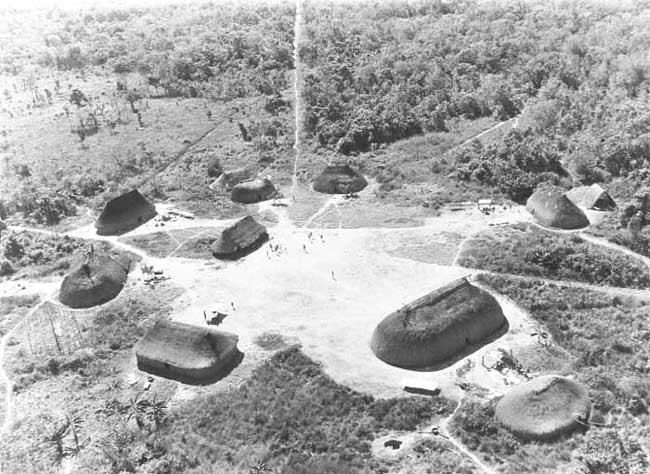
The Mehinako say that their present village, Uyapiyuku, was planned according to the same patterns as all prior villages, since the time of Creation: it has to be between two rivers, the Tuatuari, to the west, and the Kurisevo, to the east. When the sun rises, its way across the sky must be parallel to the great way that goes from the port of the Kurisevo to the center of the village. The men's house must divide the way of the sun in two, and the bench in front of the men's house must provide a free view over the road to the east, through the forest. In passing over the men's house, the sun must follow the great way west to the place where people bathe, where it finally sets. Thus, the terrestrial plane of the village reflects the architecture of the sky.
The village seems to be divided in two by a great diametrical line that crosses it from east to west. This line is the main road that leads to the area for bathing and to the port along the Kurisevo. The houses are arranged around a great circle, precariously drawn, that goes around the "men's house". Inside each house, the owner (the one who initiated its construction) sleeps closer to the way of the sun than any one of the other residents. Status is also firmly associated with location in the house, since the dwelling-places of the chiefs are only built near the main road, on one of the cardinal points. The common men build their houses between the principal residences.
In the region of the plaza in front of the men's house, the inhabitants of the village make decisions, make speeches, perform rituals and cultivate an eminently public sociability. Literally, the word used for plaza, wenekutaku, means "place often used". Other sub-regions of the plaza also have specific names. The "wrestling field", kapitaku, is set aside for wrestling sessions in the afternoon. The "shamans' circle", yetemá, is where every night the shamans of the village get together to smoke and discuss the happenings of the day. The cemetery is also located on the plaza and, as the Mehinako say, it is connected to the sky by an invisible trail that goes out from the village.
Male activities are situated outside the house, such as hunting, fishing, public socializing and wandering in the forest. Thus, the house is associated with the female domain, in opposition to the plaza and the rest of the village which is associated with masculinity.
Each house ideally is built in such a way that the back part faces the center of the village. There, at the end of the afternoon and beginning of the evening, the women sit to converse, to remove ticks from each other and to watch the men's wrestling matches.
The area of the house in front of the back door is used for throwing trash and for a great number of daily activities, such as preparing manioc in the dry season, cleaning fish, weaving baskets, carving wood, chatting with members of the same residence and, secretly, proposing extraconjugal relations.
On entering for the first time through the low entrance door of a Mehinako house, the visitor is surprised by a sensation of vast and dark space, since there are very large pillars inside the house. As there are no windows and the front and back doors let little light enter, there is a big contrast between the clarity of the plaza and the darkness of the interior. At night, after the doors are closed so that mosquitos and witches – which, it is believed, wander through the darkness - don't enter, the only light is that which comes from the small fires that the Mehinako light next to their hammocks.
The ground of the house is divided into a certain number of zones, each one of which is associated with a set of social activities. The area around the front entrance is the place for manual labor, for taking care of the children and for keeping up with what's going on on the plaza. It's also there that visitors are received.
The center part of the house is used as a cupboard, work area and kitchen.
A large shelf, at the base of the main posts of the house, supports various tall manioc containers. In this area, the women prepare fish and manioc bread, using a ceramic bowl and wooden mortar.
The sleeping areas are situated on the other side of the two principal hammock posts, which are the heaviest in the structure of the house. The nuclear families put their hammocks up next to each other, share a common nucleus of space and even keep their personal objects on common shelves, or hang them on the beams by means of long ropes. But they are private parts of the house and only occasionally is a friend invited to sit in the hammock of another person.
Relations with upper-xinguan peoples, other peoples of the Park and with the whites
The Mehinako are assiduous participants in the system of trade of the peoples of the upper Xingu. In a way that is similar to several of the other upper Xingu groups, they divide the world of humans into three categories: wajaiyu, kajaiba and putaka. According to the Mehinako, all the people of the upper Xingu, putaka, have a single origin. All, the Mehinako say, "eat the same foods".
The wajaiyu are the "wild Indians", who live beyond the frontiers of the Upper Xingu world and with whom they have lived since the arrival of the Villas-Bôas brothers and the creation of the Park. In the past, the Mehinako suffered attacks from the Ikpeng, Suyá and other wajaiyu peoples who had attacked the upper Xingu peoples in search of women and ceramic pots. An historic village of the Mehinako is located at the place where a Suyá was killed by furious residents, and is for that reason today called place of the Suyá (Suyapuhi).
The Mehinako explain the differences between them and the wajaiyu in terms of mythology. In ancient times, the Sun made the people of the upper Xingu, giving each of them a place to live and a way of life. The wajaiyu (represented, in many myths, as progeny of the animals) never obtained the rituals, implements and the culture of the peoples of the upper Xingu.
The wajaiyu are examples of all that could be wrong in human behavior. Recently, with the Mehinako being free of invasions, interaction with individuals considered as wajaiyu has increasingly gained space, especially in the soccer matches, in commercial partnerships and in the political articulations among the peoples who live in the Park, principally those involved in the defense of their territory. Since the creation of the ATIX (Indigenous Land Association of the Xingu), in 1995, the Mehinako have participated in large assemblies with all of the other leaders of the PIX (Xingu Indian Park), during which they have discussed the vigilance and defense of the territory, health, education and economic alternatives for their territory. Besides that, the fact that they are responsible for the administration of the PIV Kurisevo means that the Mehinako maintain a strong political articulation with the peoples of the "Lower Xingu", especially the Kaiabi and Yudjá, who participate in the Frontiers project - for watching over and defense of the territory - by the ATIX.
Now the idea they have of the Karaiba, the white men, is that they are children of the sun like the Mehinako themselves. Their technological civilization is a gift from the sun, their specific customs and physical appearance are perpetuated by following their culture and, especially, by eating their unique foods. A Mehinako man explained the significance of food in the creation of differences between the peoples of the Xingu, the wild Indians and the white men: "Your semen is made of coffee, milk, soup, and hot chocolate; of rice, beans, and the meat of animals. From Guaraná also. Your semen is, like these foods, sweet. And your children are big because your food is sweet. But your food is different. Our food has no taste, and our blood is different. Our children are small and different from yours. For that reason the children of the Japanese and the wild Indians are different from ours. Their food and the semen of their fathers are different from ours".
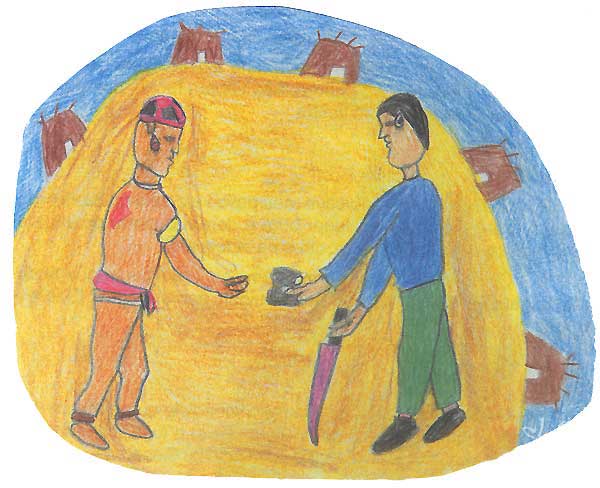
In relation to the whites, the Mehinako still have difficulty in understanding the decrease in the political activity of the Funai, which resulted in the decrease of presents offered at the Leonardo Post. In general, despite a generally positive experience with the whites, the kajaiba are still deeply uncomfortable to the inhabitants of the villages. It is significant that in the Mehinako system of dream interpretation, the white man appears as an omen of sicknesses, known as kajaiba ipyana, or "sorcery of the white man". On the other hand, the Mehinako have sought to make a strong alliance with the prefecture of Gaúcha do Norte, seeking above all another source of goods, such as gasoline, school material and salaries for the indigenous teacher.
Another notable presence of the universe of the whites in their area is a missionary who lives in the village and whose wife is a Terena Indian. He teaches in the school, along with the indigenous teacher. Although he is quite unprepared pedagogically, the missionary has succeeded in gaining the trust of the leaders of the village
Beyond the limits of the Xingu, the Mehinako have sought to publicize their culture among the Karaija through the publication lof a book with photos and video, with support from Rainforest (an NGO) of Japan. They also participate in the project "Passage Rite", which promotes the presentation of indigenous dances and songs in the cities of Rio de Janeiro and São Paulo.
Language
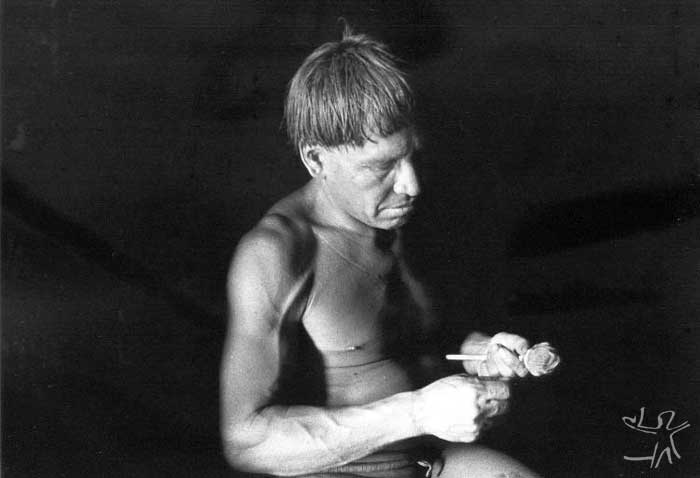
In the midst of many similarities among the peoples of the upper Xingu, the most relevant feature which differentiates them is their language. "Only those who speak our language are like us", a Mehinako chief once said in a speech on the plaza of the village. Speakers of a language of the Arawak family, the only group who speaks a close language are the Waujá, often referred to by the Mehinako as "our others", an expression of kinship and proximity. The other peoples of the Xingu, for their part, can simply be called "others".
The question of common speech is very important to the Mehinako, since they only feel at ease in speaking other languages that they really know. Men and women who marry in other villages resist speaking a new language in an incorrect way, seeking to learn it beforehand. Even when they totally dominate the language, the Mehinako are reticent to use it in public situations.
The waujá variant of Aruak is intelligible to speakers of Mehinako, but the languages have several differences. Many terms of basic vocabulary are distinct, as well as verb endings and the phonetic system.
System of commercial trade
The trade of specialized commercial items is an important basis of the upper Xinguan system. The commercial system is valued as much for the merchandise it supplies as for the system of interdependence that it establishes. The traditional specialty of the Mehinako in commercial trade is salt obtained in the dry season, in August. In this period, all the inhabitants of the village available for making the trip go to a traditional village site, where each family works to produce salt (which is not sodium chloride but rather potassium chloride). This ingredient is a central element in Mehinako cooking, and is also highly valued by other Xinguan peoples, who come during the year to the Mehinako villages to trade wooden dishes, ceramic bowls, collars and shell belts for large quantities of salt. Members of other ethnic groups also go to the Mehinako for cotton, which the inhabitants of the village produce in quantities that exceed their needs.
Rituals
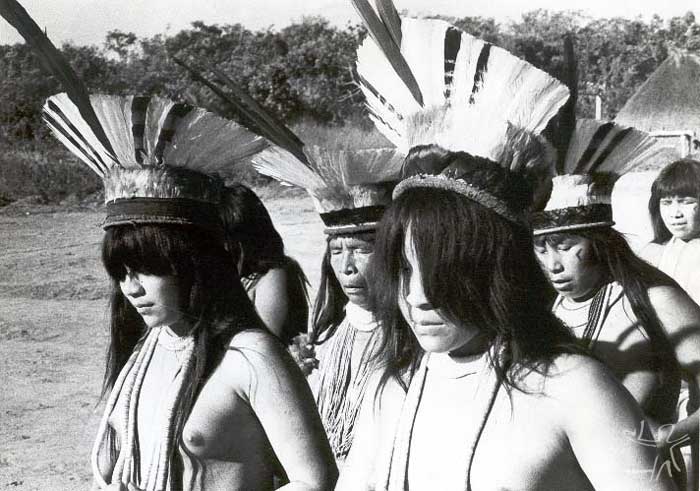
The Mehinako and their cerimonial culture are central to the Xinguan religious system. Many of the most important ritual chants are sung in Mehinako, and many of the spirits also recognized in other villages seem to have names of Arawak origin. According to the anthropologist Ellen Basso, for example, the Kalapalo sing ritual music in Mehinako, although these Karib-speaking peoples do not understand Arawak.
Like other peoples of the upper Xingu, the Mehinako participate in most of the intertribal festivals that commemorate the installation of new chiefs and the ear-piercing of boys (pihika), the mourning for the recently-deceased (ata kaiumãi, which corresponds to the Kwarup, in the Kamayurá language), the festivals of trade in the rainy season (huluki), and a large number of minor cerimonies. The inhabitants of the village send cerimonial ambassadors (waka) to take their invitations accompanied by presents and stylized speeches.
The Mehinako ritual system is similar to that of other peoples of the upper Xingu with regard to general structure, which relies on cerimonial "sponsors" and "performers". With the exception of their close allies the Waujá and, possibly, the Yawalapiti, the other Xinguan communities have local ritual variations, but the system is sufficiently open to accept these variations.
In these rituals, the chiefs are associated with the gathering of pequi at the end of each year. According to Mehinako beliefs, plantations are the home of the spirits, who are the true owners of pequi. These spirit-owners are appeased in the course of rituals performed over a period of approximately six weeks, during which the spirits, personified by the participants, are brought to the village, ritually fed, and then sent back to their plantations with prayers for more pequi in the years to come. Among the spirit-owners of the plantations is matapu, the spirit of the hummer, the focus of an important ritual that lasts three days. In the course of this ritual, the inhabitants of the village make hummers (an object comprised of a stick with a wooden plate at the end which, when swung around, produces a humming noise) that are hung up in the men's houses and kept at a distance from the women of the village.
Intermarriages
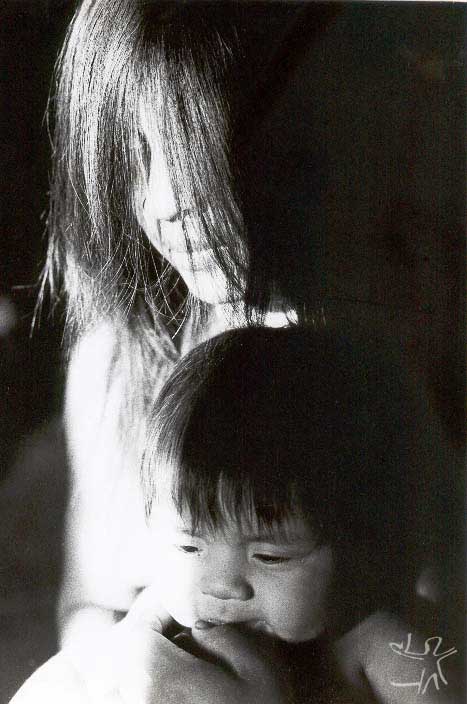
The flow of merchandise and cerimonial services among the different peoples is part of a wider system of exchange, the principal component of which is people. Visits to other groups are motivated by a desire to establish commerce, to get away from the same old social pressures at home, to watch rituals in other villages and, even, to look for spouses in another group. The Mehinako, however, prefer to marry close by, but at times they don't find spouses of satisfactory age or kinship category. The solution is to obtain a spouse through the activation of ties already made firm with other communities. At present, there are kinship connections with all Xinguan groups, which serve as a basis for intertribal marriages.
The Mehinako marry with people of other Xinguan groups only as a last alternative, because they don't like the idea of losing the presence and support of children. Since there is no rule of post-marital residence that binds the children to the communities of their parents, there is always the risk that, with marriage, they will leave their group of origin.
Sources of information
- COSTA, Maria Heloísa Fénelon. O mundo dos Mehináku e suas representações visuais. Brasília : UnB, 1988. 160 p.
- --------. Representações iconográficas do corpo em duas sociedades indígenas : Mehinaku e Karajá. Rev. do Museu de Arqueol. e Etnol., São Paulo : MAE, n. 7, p. 65-9, 1997.
- --------. O sobrenatural, o humano e o vegetal na iconologia Mehináku. In: RIBEIRO, Berta G. (Coord.). Arte índia. Petrópolis : Vozes, 1986. p. 239-64. (Suma Etnológica Brasileira, 3)
- GREGOR, Thomas Arthur. Casamento, aliança e paz intertribal. In: FRANCHETTO, Bruna; HECKENBERGER, Michael (Orgs.). Os povos do Alto Xingu : história e cultura. Rio de Janeiro : Ed. UFRJ, 2001. p.175-92.
- --------. Exposure and seclusion : a study in institutionalized isolation among the Mehinaku indians of Brazil. Ethnology, s.l. : s.ed., n. 9, p.234-50, 1970.
- --------. Mehináku : O drama diário de uma aldeia do Alto Xingu. São Paulo : Ed. Nacional/ INL, 1982. (Brasiliana, 373)
- --------. Mehinaku : the drama of daily life in a Brazilian indian village. Chicago : University of Chicago Press, 1977.
- --------. Pahikyawalu : she who is covered with feces. The dialetcis of gender among the Mehinaku of Brazil. In: RANDOLPH, R.; SCHNEIDER, D.M.; DIAZ, M. N (orgs.). The dialetics of gender : anthropological approaches. Boulder : Westview Press, 1988. p. 80-90.
- --------. Social relationships in a small society : a study of the mehinacu indians of Central Brazil. s.l. : Columbia University, 1963. (Ph.D. Dissertation)
- --------; ROBARCHEK, C. Two paths of peace : semai and mehinaku nonviolence. In: GREGOR, Thomas. (ed.). A natural history of peace. Nashville : Vanderbilt University Press, 1994. p. 159-88.
- IDE, Luís. Avaliação clínica periodontal e prevalência de microorganismos periodontopatogênicos de duas tribos da região do Alto Xingu. São Paulo : USP, 2000. 70 p. (Dissertação de Mestrado)
- MEDEIROS, M. do Carmo Ivo de. Uma abordagem preliminar da etnografia da comunicação na aldeia Mehinako Alto Xingu. In: SEKI, L. (ed.). Lingüística indigena e educação na América Latina. Campinas : Unicamp, 1993. p 377-85.
- --------. Posse nominal na língua Mehinaku. Trabalho apresentado no Encontro Anual da Associação de Lingüística e Filologia da América Latina, Campinas, 1990.
- PINAGE, Paulo; D'ALESSIO, Vito. Mehinaku : message from Amazon. São Paulo : Dialeto Latin American Documentary, 2000. 120 p.
- SILVEIRA, Maria Luiza dos Santos. Identidade em mulheres índias : um processo sobre processos de transformação. São Paulo : USP-IP, 2001. 377 p. (Dissertação de Mestrado)
- TRONCARELLI, Maria Cristina (Org.). Imiehunaku iayaka : livro para alfabetização na língua Mehinaku. São Paulo : ISA, 2002. 98 p.
- Mehinacu. Dir.: Carlos Pasini. Vídeo cor, VHS, 52 min., 1991. Prod.: Granada Television International